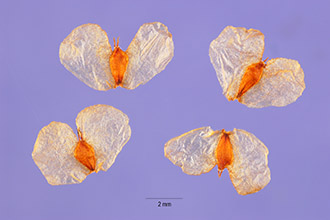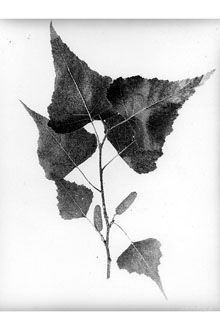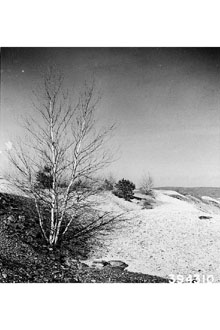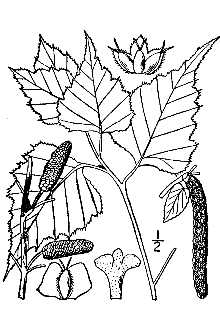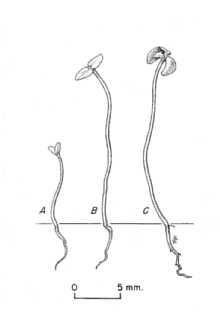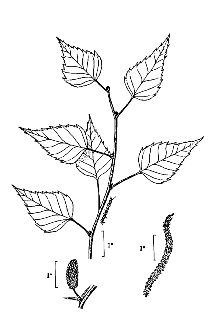Gray Birch
Scientific Name: Betula populifolia Marshall
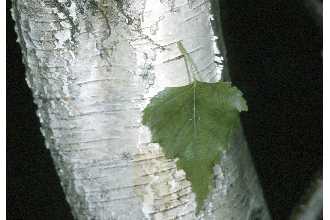
| General Information | |
|---|---|
| Usda Symbol | BEPO |
| Group | Dicot |
| Life Cycle | Perennial |
| Growth Habits | Tree |
| Native Locations | BEPO |
Plant Guide
Alternate Names
Betula alba var, populifolia, Betula populifolia forma purpurea, fire birch, old field birch, poverty birch, white birch, wire birch, , Use soil moisture sensors to measure the soil moisture of Gray Birch.
Uses
Conservation: Gray birch is a pioneer species that can tolerate multiple soil conditions. It is a good hardwood species for use in the revegetation of mine spoils and other disturbed areas. Ethnobotanic: Native Americans used a bark decoction of gray birch on swollen or infected cuts. Landscaping: Gray birch is an attractive tree that is often used as a winter landscape plant or when space limitations require the use of trees with a smaller stature. It can also be planted as a nurse tree to protect more valuable pines in the landscape that require protection to become established. Wildlife: Beavers and porcupines chew the bark of gray birch. Sapsuckers consume sap and songbirds consume the seeds. Ruffed grouse eat the catkins and buds. Snowshoe hare, moose, and white-tailed deer browse the twigs. Gray birch also provides cover for the bobcat and hare in Maine. Wood products: Gray birch is often used for fuel. It is also popularly used for woodenware such as spools, spindles, and other turned articles.
Legal Status
Status
Status
Gray birch is extinct in Delaware, endangered in Illinois, extirpated in Indiana, potentially threatened in Ohio, and rare in Maryland. Please consult the PLANTS Web site (http://plants.usda.gov) and your State Department of Natural Resources for this plant’s current status (e.g. threatened or endangered species, state noxious status, and wetland indicator values). Robert H. Mohlenbrock. 1995 USDA NRCS
Description
General: Birch Family (Betulaceae). Gray birch can be distinguished from Betula papyrifera by its tight, non-exfoliating bark. Other key characteristics include: tapered, sharp leaf tips (acuminate) and black triangular bark patches on branch bases. Several trees occur in a cluster, growing from the same root group. Gray birch is a rapid grower (0.6 m per year) and short-lived (approximately 20 years). The trees begin producing fruit at 8 years of age. Gray birch grows to 10 m tall; trunks are seldom over 1.5 dm thick. Bark is chalky-white with black triangular markings. Leaves are acuminate, with serrated edges near the tip. Male catkins (elongated flower clusters) are yellow and 1.3 to 3 cm long. Female catkins are stouter and resemble cones in appearance. Flowering takes place between April and May. Fruit sets in late summer to fall, and seeds are wind dispersed during late fall and winter. Distribution: Gray birch is native to the northeastern United States. It occurs from Nova Scotia to Southern Quebec, south to New Jersey and Pennsylvania, with outlying populations in southern Ontario, northern Ohio, northeast Indiana, and south to the North Carolina mountains. For current distribution, please consult the Plant Profile page for this species on the PLANTS Web site. Habitat: Gray birch is an early colonizer of poor sites, road cuts, and burned areas. It is listed as a common associate of the aspen-birch and beech-birch-maple communities in the northeastern hardwood forest. However, it is not an indicator any particular habitat type.
Adaptation
The USDA Hardiness zones for gray birch are 3 to 8. It grows best on moist, well-drained soil along streams, ponds, lakes, and swamps but also on dry sandy or gravelly soils. Gray birch can grow in inorganic soils of slopes and hillsides but growth is slow. Soils with high pH can cause chlorosis of the foliage. It grows easily in sun and partial shade but is shade intolerant.
Establishment
Seed heads (strobiles) should be collected when they are still a little green and then spread out in a dry place until strobiles begin to fall apart. Seeds can be easily removed from the strobiles and are best stored at 1% to 3% moisture content at 2.2 to 3.3oC. Cold storage temperatures and exposure to light aid in germination. Birch seeds can be sown after collection in the late summer or fall, or in the spring after prechilling for 4 to 8 weeks. Cover seeds with soil to one times the depth of the seed (approximately 3mm). Greenhouse temperatures should be set at alternating temperatures of 30oC for 8 hours and 20oC for 16, with light supplied during the 30oC period. Seedlings require light shade during the first 2 to 3 months of the first summer. Rooted cuttings can also produce gray birch seedlings. Collect 8 to 10 inch apical cuttings from trees in November or late March to April. Wound the base of each cutting by making two 1-inch longitudinal cuts. Apply a rooting hormone containing approximately .10% indole-butyric-acid (IBA) to the lower portion of the cutting, covering the wounds, and place each cutting in a combined medium of coarse and fine sand. If leaves are present, remove all but three apical leaves. Place cuttings in a mist bed, keeping the soil temperature at 22-24oC. Rooting will take place within 8 weeks.
Management
Gray birch is an early colonizer of disturbed sites, growing best with little competition from other species. It often forms pure stands from seedlings and root suckers. Gray birch is usually top-killed by fire, but will resprout from root suckers. The tree can be killed by fire during drought periods when soil organic matter is too dry to protect the roots. The species accumulates abundant seed banks in the soil. Seedling regeneration following fire is probable from the seed banks. Gray birch is prone to injury by snow and ice.
Pests and Potential Problems
Birch leaf miner is a pest that is disfiguring to the foliage, but does not kill the plant. Gray birch can be susceptible to the bronze birch borer that can cut off sap flow and cause branches to die back. A healthy vigorous tree is much less susceptible to attack. The best way to prevent birch borer attack is to plant the birch in a cool, moist, shady location and to keep it healthy by watering and fertilizing when needed. A birch tree planted in a sunny exposed area may lose vigor and become weakened allowing the borers to become established. Cultivars, Improved, and Selected Materials (and area of origin) The NRCS Plant Materials Program has not released any cultivars of gray birch for conservation use. Ornamental cultivars of this species include ‘Laciniata,’ with pinnately-lobed leaves, ‘Pendula,’ with drooping branches, and ‘Purpurea,’ with purple young leaves. Contact your local Natural Resources
Conservation
Service (formerly Soil Conservation Service) office for more information. Look in the phone book under ”United States Government”. The Natural Resources Conservation Service will be listed under the subheading “Department of Agriculture.”
Fact Sheet
Uses
Riparian buffers: Gray birch can add visual interest and diversity to buffer installations, except where water tables are at or near the surface. Wildlife: Birds, especially goldfinches and other small-seed eaters, feed heavily on ripe gray birch seed.
Status
Please consult the PLANTS Web site and your State Department of Natural Resources for this plant’s current status (e.g. threatened or endangered species, state noxious status, and wetland indicator values).
Description
Betula populifolia Marsh., gray birch, is a pioneer species typically found on disturbed sites with exposed, well drained soils. Gray birch is a moderate sized tree with fast growth (2-5 ft/yr) on sites with nutrient availability. The bark of sapling and pole aged plants is white, but not as bright or as papery as that of paper birch. Beyond the pole stage of growth the bark quickly develops black and rough patches, with white remaining between them. Gray birch has strong terminal growth and is typically well-formed with relatively small diameter branches. The leaves of gray birch are narrowly triangular with larger serrations along the edge than paper birch. The fall color of gray birch is a bright yellow. In eastern Pennsylvania where the ranges of gray and river birch overlap, the salmon colored bark and wider leaves distinguish the river birch.
Adaptation and Distribution
Distribution , Use soil moisture sensors to measure the soil moisture of Gray Birch.
Distribution
Gray birch is adapted to soils with poor and excessive drainage. However, it is much more common on dry, disturbed soils throughout much of its range. Gray birch is native to eastern Pennsylvania, New Jersey, and New York (roughly the I-81 corridor) to the Canadian Maritime Provinces. It is often in association with conifers such as white pine and scotch pine where seed sources exist. It is often the first tree species to invade disturbed droughty sites and tends to inhibit other vegetation by utilizing the available soil moisture and nutrients. Gray birch, as a pioneer species, prefers sites with ample sunlight and is shade intolerant. It is not tolerant of flooding of any significant duration. Robert H. Mohlenbrock USDA NRCS. 1995. Northeast Wetland Flora @USDA NRCS PLANTS For a current distribution map, please consult the Plant Profile page for this species on the PLANTS Website.
Establishment
As noted above, gray birch is a rapid invader on disturbed sites when local seed sources exist. With mature trees in the vicinity there is little need to plant gray birch. Seedlings of the species, whether wild or nursery grown, are easily transplanted and are widely adapted to soil conditions. Due to their rapid growth in the nursery, stock is outplanted as 1 yr or 2 yr field grown bareroot seedlings. Gray birch, like all seedlings, requires protection from competing vegetation and weeds to achieve acceptable growth rates. Planting dates for trees and shrubs vary depending upon their classification as conifers or deciduous. Gray birch can be planted in the spring or fall after the leaves have turned color. The seedlings will respond best if planted as early in the spring as possible, or as soon as the plants are dormant in the fall. Both situations allow for root growth and settling of the soil before leaf-out or cold drying winds increase moisture stress. In the nursery seed can be planted without stratification. Seed must be planted very shallowly to allow for light to help trigger germination.
Management
Maintaining suppression of grasses and weeds is the key to success with woody plantings. On sites where gray birch seeds in from surrounding mature trees, the birch may have to be controlled to avoid too much competition with other desirable species. Soil amendments are generally not needed for acceptable growth of this species.
Plant Traits
Growth Requirements
| Temperature, Minimum (°F) | -35 |
|---|---|
| Adapted to Coarse Textured Soils | Yes |
| Adapted to Fine Textured Soils | Yes |
| Adapted to Medium Textured Soils | Yes |
| Anaerobic Tolerance | None |
| CaCO3 Tolerance | Medium |
| Cold Stratification Required | Yes |
| Drought Tolerance | Medium |
| Fertility Requirement | Low |
| Fire Tolerance | Medium |
| Frost Free Days, Minimum | 90 |
| Hedge Tolerance | Low |
| Moisture Use | Low |
| pH, Maximum | 6.5 |
| pH, Minimum | 3.5 |
| Planting Density per Acre, Maxim | 1200 |
| Planting Density per Acre, Minim | 700 |
| Precipitation, Maximum | 65 |
| Precipitation, Minimum | 36 |
| Root Depth, Minimum (inches) | 18 |
| Salinity Tolerance | Medium |
| Shade Tolerance | Intermediate |
Morphology/Physiology
| Bloat | None |
|---|---|
| Toxicity | None |
| Resprout Ability | Yes |
| Shape and Orientation | Erect |
| Active Growth Period | Spring and Summer |
| C:N Ratio | Medium |
| Coppice Potential | No |
| Fall Conspicuous | Yes |
| Fire Resistant | No |
| Flower Color | Brown |
| Flower Conspicuous | No |
| Foliage Color | Green |
| Foliage Porosity Summer | Moderate |
| Foliage Porosity Winter | Porous |
| Foliage Texture | Fine |
| Fruit/Seed Conspicuous | No |
| Nitrogen Fixation | None |
| Low Growing Grass | No |
| Lifespan | Short |
| Leaf Retention | No |
| Known Allelopath | No |
| Height, Mature (feet) | 25.0 |
| Height at 20 Years, Maximum (fee | 25 |
| Growth Rate | Rapid |
| Growth Form | Thicket Forming |
| Fruit/Seed Color | Brown |
Reproduction
| Vegetative Spread Rate | None |
|---|---|
| Small Grain | No |
| Seedling Vigor | Medium |
| Seed Spread Rate | Rapid |
| Seed per Pound | 4256000 |
| Fruit/Seed Persistence | Yes |
| Propagated by Tubers | No |
| Propagated by Sprigs | No |
| Propagated by Sod | No |
| Propagated by Seed | Yes |
| Propagated by Corm | No |
| Propagated by Cuttings | Yes |
| Bloom Period | Mid Spring |
| Commercial Availability | Routinely Available |
| Fruit/Seed Abundance | High |
| Fruit/Seed Period Begin | Summer |
| Fruit/Seed Period End | Fall |
| Propagated by Bare Root | Yes |
| Propagated by Bulb | No |
| Propagated by Container | Yes |
Suitability/Use
| Veneer Product | No |
|---|---|
| Pulpwood Product | No |
| Protein Potential | Low |
| Post Product | No |
| Palatable Human | No |
| Palatable Graze Animal | Low |
| Palatable Browse Animal | Medium |
| Nursery Stock Product | Yes |
| Naval Store Product | No |
| Lumber Product | No |
| Fuelwood Product | Medium |
| Fodder Product | No |
| Christmas Tree Product | No |
| Berry/Nut/Seed Product | No |

